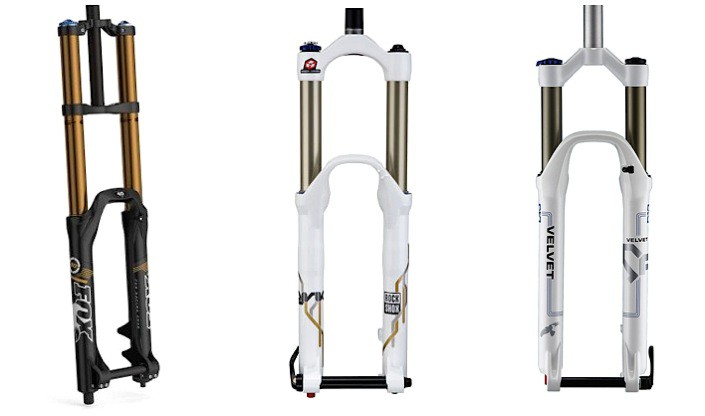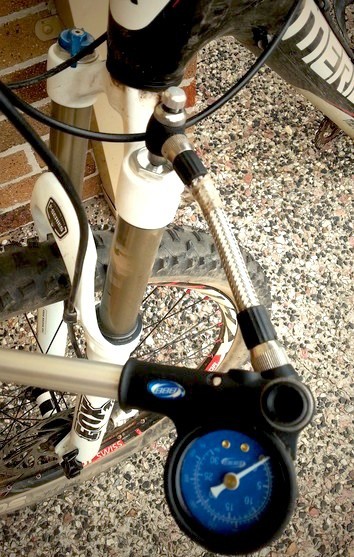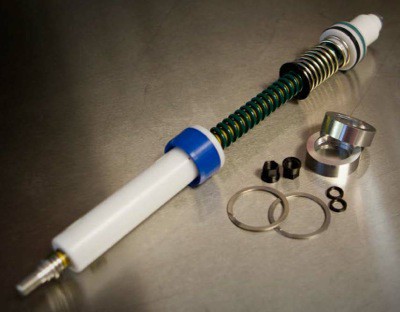
One of the biggest changes you can make to a mountain bike is upgrading the suspension fork. Forks can make or break how a bike rides and handles rough terrain. The downsides are cost: Good forks are an expensive component. Secondly, it can be a difficult and complicated decision to know which fork is best for your particular bike and riding style.
Check out "Upgrading mountain bike forks? 5 things to consider..."
for some general information about upgrading forks.

TIP: As is often the case, upgrading an old bike may not be a worthwhile procedure. With trail and cross country bikes coming in at around $1,000 with quality forks, you can pick up a great ride relatively cheaply.
Fundamentally the decision comes down to air or coil. This can be applied also to the rear shock, but here we will focus on the forks.
Air Forks
Air forks use an air chamber in the compression circuit to act as a spring. On both air and coil systems the rebound function is adjusted by limiting the flow of oil in the rebound circuit.
GET STUDYING! Check out "Guide to mountain bike suspension: An explanation of terms"
or greater insight into the workings of a modern mountain bike suspension fork.

Adjusting an air fork using a shock pump
The benefits of air forks is they are light weight and highly (and easily) adjustable for rider weight and spring stiffness. As mentioned, all you need is a shock pump (available at your local bike shop or online) to set up the fork for your weight and preference. These forks are best used for cross country, trail and all-mountain riding. In short, anything that doesn't require really long travel like downhill or freeride mountain biking.
Air forks have a progressive spring rate. This means that as the fork compresses, the air spring also compresses and the more it is compressed the harder or stiffer it becomes. On the bike this translates to the suspension becoming harder and losing its smoothness on bigger hits. Many air forks and rear shocks have been designed to rectify this progressive nature with much success.
Another problem which affects smoothness is stiction. This is the effect the positive air spring has on the suspension in the first part of the compression cycle. It can take a good hit to get the spring moving. This issue has also been rectified with the addition of the negative air spring which preloads the suspension against the positive spring, making it more supple in response to smaller hits.

TIP: If you have decided to go ahead, the first step is to know your measurements. What amount of travel will fit your bike's geometry? Steerer size? QR or thru-axle? These are the questions you need answers to before you even think about walking out the door to the bike shop or searching online.
Coil Forks

The end of coil forks? Fox has introduced the new air fork for downhill bikes. Source: Riding Feels Good
Coil forks use a metal coil as the spring (duh!). The advantage of this is the linear nature of the suspension during the compression cycle. Unlike with an air fork, the spring rate doesn't 'ramp up' as you go deeply into the travel making coil suspension unbeatable in terms of smoothness and feel.
To set up requires a bit more work though. Adjusting the fork for your weight means swapping out the coil spring for a firmer or softer option, and there may only be a handful of choices, so fine tuning isn't as precise as with an air fork. It also requires a bit more mechanical know-how. In saying that however, coil forks are simpler to maintain and service than air forks; a couple of seals and some oil is all you need to keep them running smoothly.
Coil forks are generally a bit cheaper than air but are also heavier. These forks are best used on bigger travel bikes that go deeply into their travel. They remain smooth even on the biggest hits and are very tough, making them popular with downhill riders.
A quick look in the market reveals a massive range of air fork options compared to coils. Constantly developing technology has resulted in air forks offering many advantages over coil for the average cyclist and the overall market.
Which is for you?
For a cross country or trail rider, air forks are the way to go. The ease of setup, weight and amount of adjustment makes these forks a great upgrade. There are also a heap of options available for you to check out.
If you have a big travel bike or just like to ride hard and go deep then perhaps a coil is for you. Coils are strong and the linear spring rate is hard to beat. If you get past the weight and setup challenges coil forks are great units.
As always, speak to your local bike shop about the available options and advice on an upgrade that's right for your bike and riding style.


